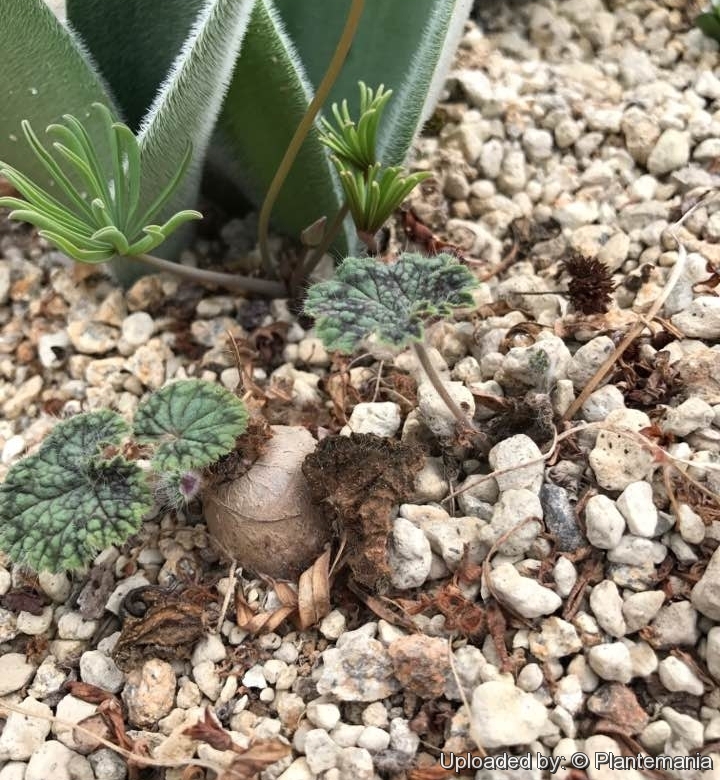




Your support is critical to our success.

Origin and Habitat: The distribution range is fairly wide, extending from Laingsburg throughout the Roggeveld to Namaqualand., Northern Cape, South Africa. Type locality: Garacoup (as "Garrakoops/Garrakoofs Poort"). Extent of occurrence 10 000 km?, Pelargonium barklyiSN|34376]]SN|34376]] has been recorded from more than 10 subpopulations.
Habitat and Ecology: Succulent Karoo. Karroid shrubland. Pelargonium barklyiSN|34376]]SN|34376]] is admirably adapted to survive long rainless summers as a dormant, subterranean, somewhat turnip-shaped tuber. Leaves are produced with the advent of the winter rains, while flowering takes place towards the end of the growing season in September or October, followed by a rapid ripening of seed and the withering of the aerial stems and leaves as summer advances. This species has no recorded threats.
Synonyms:
- Pelargonium barklyi Scott-Elliot
Description: Pelargonium barklyi is a nice geophytic plant that grows from a large tuber and attains heights of up to 30-50 centimetres. During the winter months it produces large heart shaped leaves which varies in shape and size from plant to plant. It is grown primarily for the leaf, which are very decorative. The top of the leaf is light green distinctly hairy and covered with deep-veined veins with often a dark purple zones around the edge. The underside of the leaves is deep purple. These are followed by creamy white flowers, with just a hint of a nectar guide held on long petioles. The flowers appear at the end of the winter and in early spring. The plant is dormant and leaf-less in summer. P. barklyi is unlikely to be confused with any other species having tuberous underground parts, as its leaves are so characteristic.
Derivation of specific name: The specific epithet barklyi commemorates Sir Henry Barkly who was Governor of the Cape of Good Hope from 1870 to 1877. ln 1877 he forwarded a specimen of this species, collected by Reynolds, to Scott Elliot who published the first description.
Root: Tuberous, napiform without a peeling shell or periderm.
Stems (branches): 2-3, very short, covered with the woody bases of the old leaves.
Leaves: Almost all radical, loosely arranged on exposed herbaceous annual branches. The blades are about 6 cm in diameter, cordate-orbicular, in outline, and varies in shape and size from plant to plant, their bases are cordate, shortly 7-lobed; lobes trifid and dentate; the veins on the upper surfaces are conspicuously channelled; underneath the leaves are deep purple while on the above surface a purple sub-orbicular zone can often be seen. The surfaces of the leaves (as well as the whole plant) is covered with scattered long white hairs. The margins are bearded with dense white hairs. The stipules are lanceolate-acute. The petioles are 5-10 cm long.
Inflorescences: The unbranched inflorescence ( pseudo- umbels) carries 2 to 6 single flowers. Peduncles elongate over 30-50 cm long; bracts usually 6, lanceolate. Pedicels at first nodding, then erect.
Flowers: About 25 mm in diameter. Sepals lanceolate or linear, subacute, 5-nerved 8 mm long and 2-4 mm broad; margins white and ciliated at the edge. The five petals are obovate, cuneate, cream-colored slightly pink tinted at their base and with 2 red lines twice as long as the sepals and the anterior and posterior petals are nearly equal in size. The upper two are 14 mm long and 8-10 mm broad, suddenly bent backwards by 90 degrees above their centre, the lower three are shorter than the upper ones, and only slightly bent back. Fertile stamens 7, connate at base (except the two lowest). The pollen is orange coloured. Ovary and carpophore hairy 30 mm long.
Seeds: Brown.
Chromosome number: 2n = 18.
Related species: The shape and hairiness of the leaves as well as the large creamy flowers are strongly reminiscent of Pelargonium articulatum (Cav.) Willd. but that species lacks an underground tuber, the leaves are more deeply incised, and the two posterior petals are two to three times as wide as the three anterior petals.
Bibliography: Major references and further lectures
1) J. J. A. Van der Walt, P. J. Vorster "Pelargoniums of Southern Africa", Volume 3 Juta, 1977
2) Pelargonium barklyi in: Cactus and Succulent Journal, Volume 81, 2009
3)Pelargonium barklyi in: G. F. Scott-Elliot: In: Journal of botany, British and foreign. Volume 29, London 1891, pp. 68?69
4) William Paterson, Vernon Siegfried Forbes, John P. Rourke "Paterson's Cape travels, 1777 to 1779" Brenthurst Press, 1980
5) Berthold Seemann The Journal of Botany, British and Foreign ..., Volume 29 R. Hardwicke, 1891
6) Raimondo, D., von Staden, L., Foden, W., Victor, J.E., Helme, N.A., Turner, R.C., Kamundi, D.A. and Manyama, P.A. 2009. "Red List of South African Plants". Strelitzia 25. South African National Biodiversity Institute, Pretoria.
7) Van der Walt, J.J.A. and Vorster, P.J. 1988. "Pelargoniums of southern Africa" Volume III. Annals of Kirstenbosch Botanic Garden 16:1-149. National Botanic Gardens, Kirstenbosch.
8) Foden, W. & Potter, L. 2009. Pelargonium barklyi Scott-Elliot. National Assessment: Red List of South African Plants version 2017.1. Accessed on 2017/09/06
9) F. Albers: Pelargonium barklyi. In: Urs Eggli: "Sukkulentenlexikon Volume 2 Zweikeimblattrige Pflanzen (Dicotyledonen) ausgenommen Aizoaceae, Asclepiadaceae, Cactaceae und Crassulaceae". Eugen Ulmer Verlag, Stuttgart 2002,
10) Pelargonium barklyi by Tropicos.org. In: "IPCN Chromosome Reports". Missouri Botanical Garden, St. Louis. Web: http://www.tropicos.org/Name/13900381?projectid=9
11) "Pelargonium Species One", Pacific Bulb society. Web: http://pacificbulbsociety.org/pbswiki/index.php/PelargoniumSpeciesOne
| Your Actions | |
|---|---|
| Back to Pelargonium index | |
| Back to Geraniaceae index | |
 |
Back to Succulents Encyclopedia index |
Privacy stantement - Terms and conditions - How to cite - About us - Feedback - Donate



